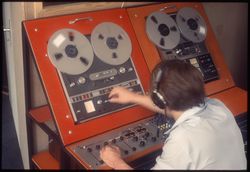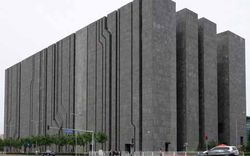photographs
Printouts of the digitized photographs for the MOMA, Banco Pinto & Sotto Mayor, Oliveira de Azeméis
AP178.S1.1971.PR01.014
Description:
Original file title : Aquisição MOMA 2012 This file includes a list of drawings.
2012
Printouts of the digitized photographs for the MOMA, Banco Pinto & Sotto Mayor, Oliveira de Azeméis
Actions:
AP178.S1.1971.PR01.014
Description:
Original file title : Aquisição MOMA 2012 This file includes a list of drawings.
photographs
2012
born digital, photographs
AP207.S1.1973.PR04.001
Description:
Most common file formats: JPEG File Interchange Format, Microsoft Word for Windows
2013 - 2018
Photographs and videos of the performance, digitized promotional poster for the performance and project description, Progetto d’Architettura n°5
Actions:
AP207.S1.1973.PR04.001
Description:
Most common file formats: JPEG File Interchange Format, Microsoft Word for Windows
born digital, photographs
2013 - 2018
born digital, photographs
AP207.S1.1973.PR02.003
Description:
Most common file formats: JPEG File Interchange Format, Microsoft Word for Windows, Windows Bitmap
2006 - 2015
Digitized “Io Sono La Spia” sign, photographs of the Global Tools team, and project description, Io Sono La Spia
Actions:
AP207.S1.1973.PR02.003
Description:
Most common file formats: JPEG File Interchange Format, Microsoft Word for Windows, Windows Bitmap
born digital, photographs
2006 - 2015
drawings, born digital
AP207.S1.1992.PR01.005
Description:
Most common file formats: JPEG File Interchange Format, Microsoft Word for Windows
2014 - 2015
Digitized presentation drawings for the proposal and project description, Studio Per Il Restauro E La Riconversione Del Forte Inglese
Actions:
AP207.S1.1992.PR01.005
Description:
Most common file formats: JPEG File Interchange Format, Microsoft Word for Windows
drawings, born digital
2014 - 2015
drawings, born digital, photographs
AP207.S1.1971.PR02.004
Description:
Most common file formats: JPEG File Interchange Format, Tagged Image File Format, Microsoft Word for Windows, Audio/Video Interleaved Format, Raw JPEG Stream
2001 - 2017
Digitized presentation drawings for the proposals, sketches, photographs of a model for Grass Architecture proposal, and project descriptions, Proposte per il concorso Trigon
Actions:
AP207.S1.1971.PR02.004
Description:
Most common file formats: JPEG File Interchange Format, Tagged Image File Format, Microsoft Word for Windows, Audio/Video Interleaved Format, Raw JPEG Stream
drawings, born digital, photographs
2001 - 2017
Audible Archives
Audible Archives presents samples of digitized recordings alongside silent artefacts from the CCA Collection, highlighting sound as a significant medium for research while drawing attention to the challenges of preservation and stewardship.
Audible Archives
Actions:
Description:
Audible Archives presents samples of digitized recordings alongside silent artefacts from the CCA Collection, highlighting sound as a significant medium for research while drawing attention to the challenges of preservation and stewardship.
born digital
ARCH280967
Description:
Labelled "AutoCAD/NthView Digitizer drivers release 2.40 sample Zoomslide"
circa 1988-1989
Various drawings of the provincial government building, Thunder Bay, Ontario, 5.25" floppy disk, 360 KB
Actions:
ARCH280967
Description:
Labelled "AutoCAD/NthView Digitizer drivers release 2.40 sample Zoomslide"
born digital
circa 1988-1989
research
The CCA Virtual Fellowship Program supports our long-term investment in thinking through how already digitized and accessible CCA Collection material can generate new historical configurations, timely interpretations, and a broader reach within architectural research.
virtual fellowship program, Nokubekezela Mchunu, Wafa Ali, Papers that Remain, post-custodial archives, Africa
1 March 2022 to 23 December 2022
CCA Virtual Fellowship Program 2022
Actions:
Description:
The CCA Virtual Fellowship Program supports our long-term investment in thinking through how already digitized and accessible CCA Collection material can generate new historical configurations, timely interpretations, and a broader reach within architectural research.
research
1 March 2022 to
23 December 2022
articles
Is a Database a Museum?
Series
Presentation files
AP195.S2
Description:
Series 2: Presentation files, 1999 – 2009, contains CAD files, 3D models, renderings, and photographs used for presentation of the Phaeno Science Centre, especially during the competition and design phases. Formats include chiefly images (EXIF, JPEG, TIFF) and CAD files (AutoCAD, plotter files, EPS). This series contains a wide variety of materials used by ZHA to present Phaeno Science Centre to clients, the press, and other stakeholders. This includes 3D models and CAD files, other drawings and diagrams, and photographs. Notably, this series includes concept animations used by ZHA to develop the shape and structure of Phaeno, as well as concept sketches possibly drawn by Zaha Hadid. Other materials of interest include a digitized copy of digital plans that had been printed and given a hand-painted rendering surface.
1999 - 2009
Presentation files
Actions:
AP195.S2
Description:
Series 2: Presentation files, 1999 – 2009, contains CAD files, 3D models, renderings, and photographs used for presentation of the Phaeno Science Centre, especially during the competition and design phases. Formats include chiefly images (EXIF, JPEG, TIFF) and CAD files (AutoCAD, plotter files, EPS). This series contains a wide variety of materials used by ZHA to present Phaeno Science Centre to clients, the press, and other stakeholders. This includes 3D models and CAD files, other drawings and diagrams, and photographs. Notably, this series includes concept animations used by ZHA to develop the shape and structure of Phaeno, as well as concept sketches possibly drawn by Zaha Hadid. Other materials of interest include a digitized copy of digital plans that had been printed and given a hand-painted rendering surface.
Series
1999 - 2009

